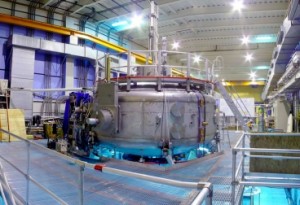A team of scientists led by Jay Kesner at the MIT Plasma Science and Fusion Center and Michael Mauel at the Columbia University Fu Foundation School of Engineering and Applied Science announced the “first significant results” from the Levitated Dipole Experiment, LDX. (Click here for the MIT news release).
As I understand it, and I am not a physicist, the experimental LDX unit is 16 feet in diameter. It houses a 1/2 ton magnet the size of a truck tire. The magnet controls the motion of the plasma, which is a hot ionized gas that swirls within the LDX. The active ingredient in the plasma is deuterium, heavy hydrogen with 1 proton and 1 neutron. I’m not sure about the plasma in the LDX, whether it is pure Deuterium or there are inert or catalytic ingredients, however, I’m not sure it matters for the purposes of this discussion on Popular Logistics.
The experiment was triggered by observations by satellite on the interaction of plasmas with the magnetic fields of Earth and Jupiter, which showed that random turbulence causes the plasma to become more densely concentrated. This, called “turbulent pinching” is counter-intuitive; typically turbulence tends to disperse molecules. The breakthrough Drs. Kesner and Muel and their colleagues achieved was to create in the lab “turbulent pinching” of the molecules of the plasma.
This could be considered “Solar Power” as the sun is a fusion reactor. The scientists at MIT and Columbia are trying to harness the forces that drive the sun. They have made progress. They have more work to do.
This is good news. As the press release says:
“The findings confirm that its unique approach has some potential to be developed as a new way of creating a power-producing plant based on nuclear fusion — the process that generates the sun’s prodigious output of energy.” Note the use of the word “Potential.”
The press release also clearly states: “Fusion has been a cherished goal of physicists and energy researchers for more than 50 years. … developing a fusion reactor that produces a net output of energy has proved to be more challenging than initially thought.”
There is no timeline for commercially available fusion power altho Popular Mechanics suggests 2035. The editors at Popular Logistics still think that conventional solar, wind, geothermal, hydro, and conservation offer the best alternatives to coal, oil, gas, and nuclear fission today and for the next 25 years.
